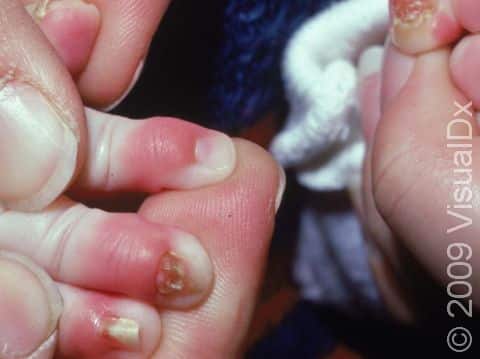Nail Infection, Bacterial (Paronychia)
Paronychia, commonly known as a bacterial nail infection, involves inflammation of the nail beds of fingers and/or toes and is usually the result of a bacterial infection (although it can be caused by a yeast or virus, typically the herpes simplex virus [HSV]). There are 2 types of paronychia; acute (short term) and chronic (long term).
- Acute paronychia appears as redness, warmth, tenderness, and swelling along the edge of the nail. It often occurs as a result of a break in the skin.
- Chronic paronychia will appear the same way but is a more gradual development, and may be the result of finger or thumb sucking common in infants. It may also form as the result of debris underneath the fingernail, which becomes a favorable environment for bacteria to grow. It is important to keep infants’ hands clean and dry, especially when they become old enough to grasp objects.
Who's At Risk?
Acute paronychia may occur at any age but is particularly common in children. Chronic paronychia is most common in adult women and those who work in places where their hands are kept moist, but it has been seen in infants who suck on the thumb or fingers, or in those whose caretakers over trim the infant’s fingernails.
Signs & Symptoms
Bacterial nail infection most often affects the proximal nail fold of the fingers and, less commonly, can affect the toes.
- Acute paronychia: The proximal nail fold is red, swollen, painful, and may contain pus. Usually one nail is affected.
- Chronic paronychia: The proximal nail fold is swollen, red, and has no cuticle (the strip of hardened skin at the base and sides of a fingernail or toenail). One or more nails may be affected.
Self-Care Guidelines
- Try soaking the nails in warm water for acute paronychia.
- Avoid water and chemical exposure to prevent symptoms of chronic paronychia.
Treatments
For acute paronychia, the doctor may:
- Puncture and drain the affected area and test for bacteria or viral infection.
- Prescribe antibiotics for a bacterial infection or an antiviral medication for a herpes infection.
For chronic paronychia, the doctor may:
- Prescribe a topical steroid.
- Prescribe a topical antifungal medication.
- Prescribe topical or oral antibiotics.
Visit Urgency
See your child’s doctor for evaluation if you notice signs of bacterial nail infection.
References
Bolognia, Jean L., ed. Dermatology, pp.263-264, 1072. New York: Mosby, 2003.
Freedberg, Irwin M., ed. Fitzpatrick’s Dermatology in General Medicine. 6th ed. pp.660, 2590. New York: McGraw-Hill, 2003.
Last modified on August 16th, 2022 at 2:44 pm

Not sure what to look for?
Try our new Rash and Skin Condition Finder
